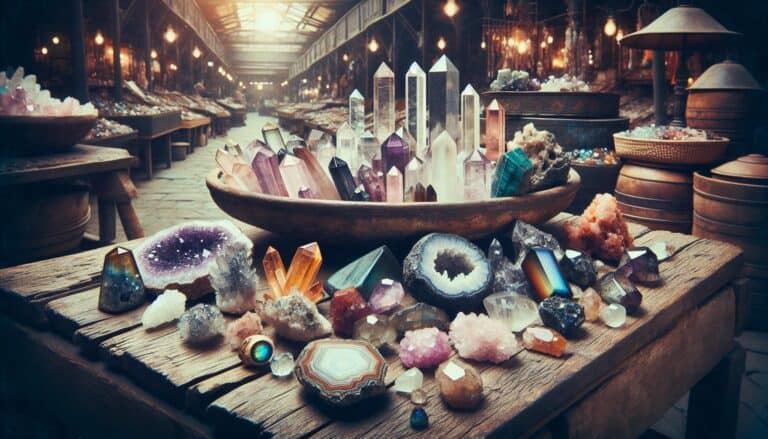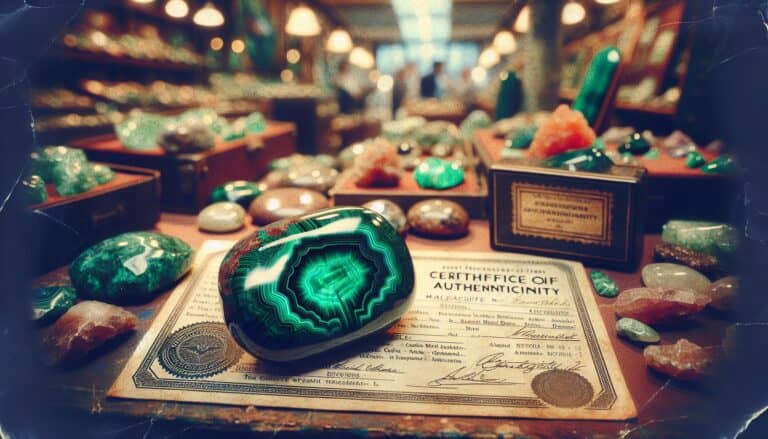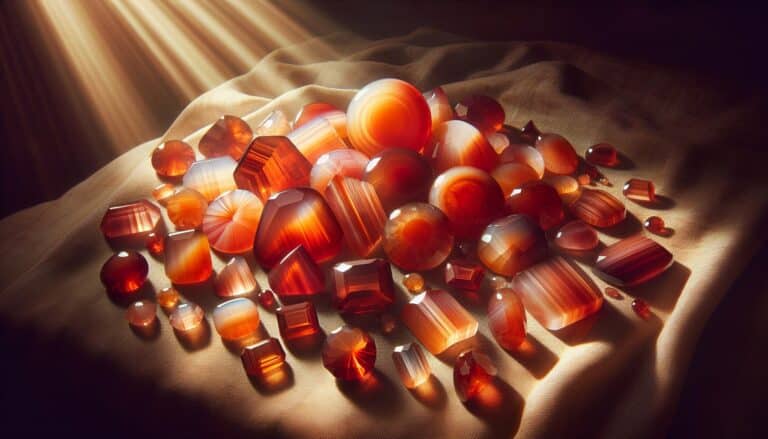Identifying minerals like anglesite can be a fascinating journey into the world of geology.
You might have stumbled upon a specimen and are curious if it’s the real deal. Anglesite, a lead sulfate mineral, is known for its high density and brilliant luster, making it quite distinctive.
To confirm you’ve got anglesite in your hands, you’ll need to look at specific characteristics. Its crystal system, hardness, and ability to fluoresce under UV light are key identifiers.
Let’s delve into the nuances that make anglesite stand out from its mineral kin.
Identifying anglesite involves inspecting its high density, luster, and orthorhombic crystals. Key tests include a white streak test, magnet test (non-magnetic), hardness test (2.5-3 on Mohs scale), and refractive index measurement (1.878-1.893). Anglesite is usually transparent to translucent, with a specific gravity of 6.3-6.5.
How to Identify anglesite Through Testing
Visual Inspection
Start with a visual examination to look for the telltale signs of anglesite, such as its high density and brilliant luster. What sets it apart is its crystal system – anglesite forms in the orthorhombic system and often presents tabular or prismatic crystals. Colors vary from white to gray, with occasional shades of blue or green.
The Streak Test
Scratch the mineral across an unglazed porcelain plate, a method known as the streak test, to reveal its powder color. Anglesite streaks tend to be white, which helps differentiate it from other minerals with similar appearance.
Magnet Test
Anglesite is non-magnetic, so bringing a magnet near your sample can quickly rule out minerals with magnetic properties. If there’s no attraction, your sample could indeed be anglesite.
Hardness Test
Using the Mohs scale, you can perform a hardness test. Anglesite falls between 2.5 to 3 on the scale, meaning it can be scratched by a copper penny but not by your fingernail.
Birefringence Test
Under a petrographic microscope, you’ll check for birefringence — a property where a mineral shows different colors or different brightnesses as the stage is rotated. Anglesite’s birefringence is rather low, so there won’t be significant changes in color or brightness.
Checking The Diaphaneity
Examine your anglesite for transparency or translucency. Due to its high refractive index, anglesite can range from transparent to translucent — a flashlight test will reveal how light passes through the sample.
Single or Double Refraction
Perform a refraction test using a dichroscope, if available. Anglesite only shows single refraction, lacking the double refraction seen in minerals like calcite.
Refractive Index Test
Anglesite has a relatively high refractive index, usually between 1.878 to 1.893. This test, conducted with a refractometer, can confirm if you’re handling anglesite or a different mineral.
| Property | Value |
|---|---|
| Refractive Index | 1.878 to 1.893 |
Finding The Specific Gravity
An essential step in confirming anglesite is measuring its specific gravity, which is notably high, around 6.3 to 6.5. Precision scales or a hydrostatic balance will help in obtaining accurate measurements.
| Property | Specific Gravity |
|---|---|
| Anglesite | 6.3 to 6.5 |
Identifying Anglesites in the Field
Look for anglesite in lead mining areas, where it can form as a secondary mineral. Its high-density feel and its reaction to UV light, glowing lightly, can be good indicators when in the field.
Recognizing Potential Anglesite Rocks
You may find anglesite associated with galena, another lead ore, so checking for the presence of galena can be a good clue. Additionally, being aware of the geological context, such as whether you’re in an area known for sedimentary deposits where anglesite might form, will assist in making a correct identification.
Physical Characteristics of anglesites

Anglesite beams with a distinctive luster that catches the eye. Your initial glance will likely be drawn to its bright adamantine to vitreous luster. This mineral stands out with a clear to white hue, though impurities may give it a shade of other colors like gray or blue. As its attractiveness spikes curiosity, you’ll also note the transparency of anglesite, which can range from transparent to translucent.
As you dive deeper into anglesite’s physical attributes, you’ll notice its brittle nature, especially when subjected to a blow. This trait is a tell-tale sign that helps differentiate anglesite from similar-looking minerals which may be more pliable.
Anglesite typically forms in a variety of crystal shapes. However, the most common manifestation of anglesite is in thin to thick tabular and prismatic crystals. It’s pivotal to recognize the mineral’s orthorhombic crystal system, where crystals form in a pattern that’s often symmetrical and elongated.
The cleavage of anglesite is another distinguishing feature. You’ll find it has perfect cleavage in one direction and good cleavage in another, making it susceptible to splitting along distinct planes.
Touching upon the specific gravity confirms your hypothesis about anglesite’s density; it averages a hefty 6.3, significantly denser than many common minerals. This weightiness is a clue to the lead content anglesite carries, hinting at its chemical composition of lead sulfate (PbSO4). When you’re analyzing a potential anglesite sample, keep these traits at the forefront of your evaluation to ensure accurate identification.
How Are anglesite Formed?
Anglesite typically forms from the oxidation of lead sulfide ore, particularly galena. As galena oxidizes, it transforms into several secondary lead minerals, and anglesite is among these. The oxidation process involves the reaction of galena with oxygen and sulfuric acid, leading to the creation of anglesite’s distinctive PbSO4 composition.
Environmental conditions play a crucial role in the formation of this mineral. Anglesite can crystallize in a range of settings, including the oxidized portions of lead ore deposits. Here, it appears as an alteration product of primary lead minerals. You’ll often find anglesite in association with other secondary minerals like cerussite (lead carbonate) and malachite (copper carbonate).
- Geological Occurrence: Often found in hydrothermal veins.
- Formation Temperature: Typically forms at low temperatures.
- Chemical Conditions: Requires an environment rich in sulfuric acid.
The presence of anglesite in a mineral deposit can indicate secondary enrichment, a process that can make such deposits richer in lead. While lead sulfide is the main source mineral for anglesite, secondary enrichment involves the concentration of lead due to the leaching of other elements.
By understanding how anglesite is formed, you’re better equipped to identify it when examining mineral samples. Keep in mind that the formation conditions can also affect anglesite’s physical characteristics and crystal habits, adding another layer to its identification.
Preparation for anglesite Hunting
Gathering the Right Tools
To increase your chances of successfully identifying anglesite, having the right tools at your disposal is crucial. Imagine you’re a detective; just as they need their trusty magnifying glass, you’ll need your own specialized equipment. Here’s what you should include in your toolkit:
- Hand Lens: To scrutinize anglesite’s fine details, a hand lens or jeweler’s loupe with a magnification of 10x will become your best friend.
- Geologist’s Hammer: For extracting samples, a sturdy geologist’s hammer is essential. Remember, safety goggles are a must when using this tool.
- Streak Plate: A streak plate will help you perform the streak test, a reliable identification method mentioned earlier.
- Hardness Test Kit: As hardness is a vital clue, include a hardness test kit that typically comes with a set of picks for gauging mineral hardness.
- Specific Gravity Kit: This complex-sounding kit is simply a balance or scale to measure how heavy a mineral is for its size, helping confirm if the specimen is heavy like anglesite.
- Field Guide: Don’t forget a field guide with information on anglesite to compare your findings on the spot.
Safety Considerations
When you’re on the hunt for anglesite, your safety takes precedence. There are several hazards you need to be aware of before stepping out:
- Proper Footwear: Wear boots with ample traction to prevent falls on slippery terrain.
- Protective Clothing: Durable gloves and long sleeves will protect your skin from sharp rocks and potential skin irritants.
- Navigation Tools: Your smartphone or a traditional compass and map are indispensable to avoid getting lost.
- First Aid Kit: Always carry a basic first aid kit, as accidents can happen no matter how cautious you are.
- Adequate Water and Food: Staying hydrated and energized is essential; never underestimate the physical toll that mineral hunting can take on your body.
- Weather Appropriate Gear: Check the weather before you go and dress accordingly. Weather can change rapidly, especially in mountainous regions where anglesite is commonly found.
By thoroughly preparing for your anglesite hunt with the appropriate tools and safety measures, you’re setting yourself up for a fruitful and secure endeavor. Remember, the key to a successful identification starts even before you spot the mineral.
Handling and Care of Found anglesites

Once you’ve successfully located and identified anglesite, proper handling and care are paramount to maintain the mineral’s quality and to safeguard its integrity. This segment of the article will walk you through the essential steps for cleaning and storing your anglesite specimens.
Cleaning and Storing Anglesites
Handling anglesite with care is critical right from the moment you unearth it. You want to ensure that the luster and crystal structure remain intact through the cleaning and storage processes.
Cleaning Your Anglesite Specimens
To start, you’ll need to remove any loose dirt or debris gently with a soft brush. Avoid using metal tools which can scratch the surface of your anglesite. For encrusted dirt, soak the mineral in a solution of warm water and mild detergent for several hours, then rinse with clean water. If you encounter stubborn residues, consider using a plastic pick or a wooden toothpick to carefully dislodge the material without damaging the specimen.
It’s important to remember that anglesite is sensitive to temperature changes and chemicals. Never use harsh cleaning agents or hot water as these can cause fractures or alter the mineral’s natural color.
Storing Your Anglesite Safely
After cleaning, storing anglesite requires attention to detail to prevent damage:
- Wrap each specimen individually in a soft, lint-free cloth or place it in a padded compartment.
- Use a sturdy box or container that’s large enough to prevent crowding, which could lead to scratches or chipping.
- Label each specimen with relevant information such as the date of discovery and the location where it was found.
To further protect your anglesite, ensure the storage area is:
- Cool and dry to prevent any potential degradation from humidity or temperature fluctuations.
- Free from heavy traffic; vibrations and continual movements can dislodge or damage the crystals.
By meticulously cleaning and storing your anglesite specimens, you’re not only preserving their aesthetic appeal but also their geological significance. Your efforts will significantly contribute to the longevity and quality of your mineral collection.
Conclusion: Confirming Anglesite Real
You’ve now got the know-how to identify anglesite with confidence.
Remember, a keen eye for detail and a systematic approach to testing are your best tools. Careful handling, cleaning with a gentle touch, and proper storage will preserve the beauty and value of your anglesite specimens. Armed with these insights, you’re ready to appreciate anglesite’s unique properties and secure its place in your collection.
Embrace the process and enjoy the rewards of your geological pursuits.







